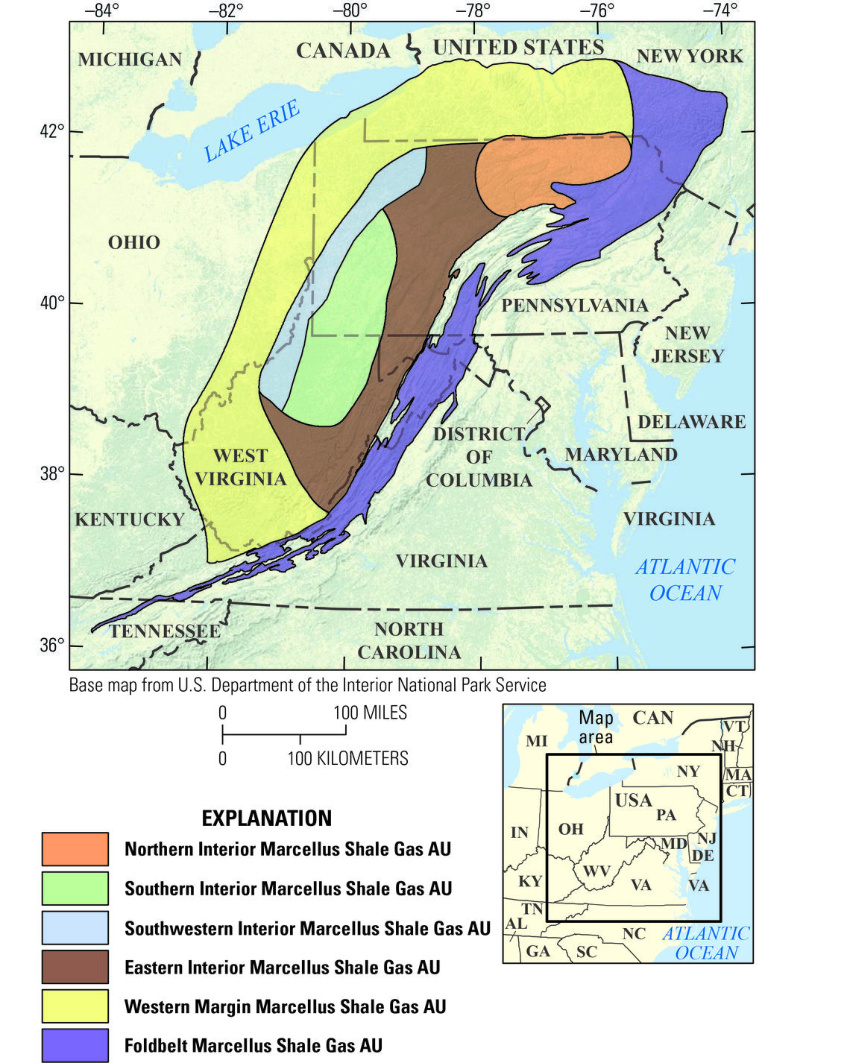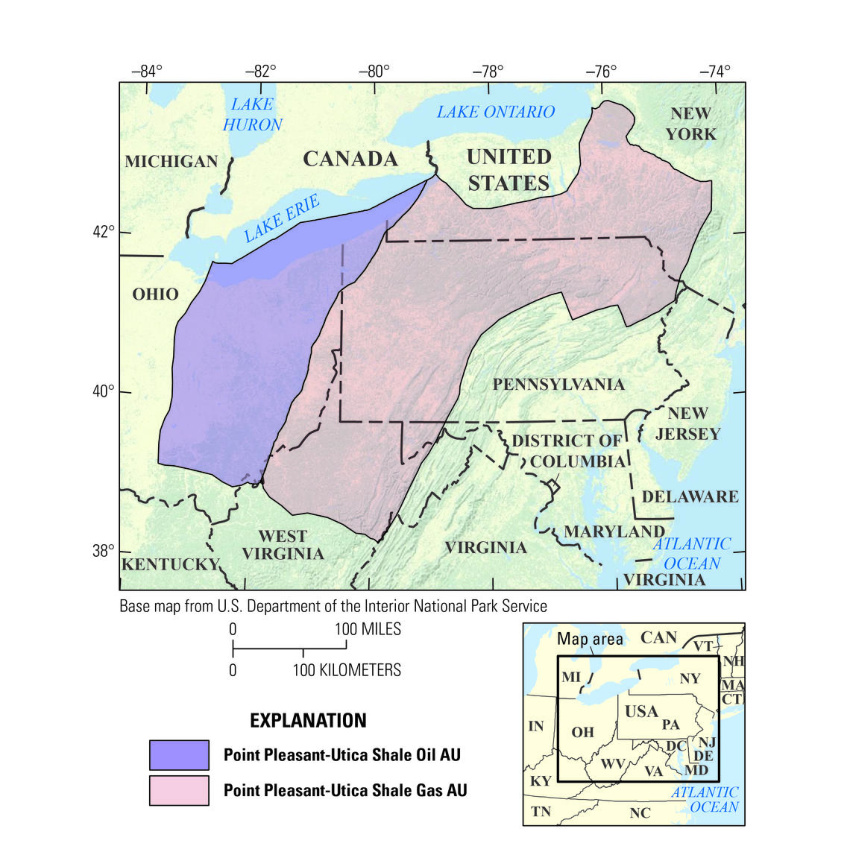
(Source: Shutterstock.com)
Knowledge gained from geological and technical advances has prompted the U.S. Geological Survey (USGS) to up its estimates of undiscovered technically recoverable natural gas resources for the Appalachian Basin’s Marcellus and Point Pleasant-Utica shale formations by about 75% to a combined 214 trillion cubic feet (Tcf).
The assessment, released last week by the USGS, represents a significant jump from estimates delivered in 2011 for the Marcellus and 2012 for the Utica. Back then, the USGS put Marcellus Shale’s estimate at a mean of 84 Tcf and the Utica Shale at 38 Tcf.
The latest assessment, which covers parts of Kentucky, Maryland, New York, Ohio, Pennsylvania, Virginia and West Virginia, focuses on the formations’ remaining resources and does not include produced oil and gas, the USGS noted in its report.
“Watching our estimates for the Marcellus rise from 2 trillion to 84 trillion to 97 trillion in under 20 years demonstrates the effects American ingenuity and new technology can have,” USGS Director Jim Reilly said in a news release. “Knowing where these resources are located and how much exists is crucial to ensuring our nation’s energy independence.”
The report was released as operators in the Appalachian region continue growing gas production volumes in a low-price environment. It also comes the world looks to natural gas as a route to a lower-carbon future, using it to fuel power plants and as feedstock to produce chemicals among other uses.
“Since our assessments in 2011 and 2012, industry has improved upon their development techniques for continuous resources like the shale gas in the Appalachian Basin,” Walter Guidroz, program coordinator for the USGS Energy Resources Program, said in the release. “That technological advancement, plus all of the geological information we’ve gained from the last several years of production, have allowed us to greatly expand our understanding of these formations.”
In the report, the USGS described the Marcellus Shale as being mostly organic-rich marine mudrock containing self-sourced petroleum resources based primarily on thermal maturation in petroleum productive areas.

“The extent of potential Marcellus Shale resources is based mainly on depths to the base of the mudrock of greater than 1,000 ft (304.8 m), a vitrinite reflectance equivalent of 0.5% and greater, and 25 ft (7.6 m) and greater thicknesses of organic-rich and brittle lithofacies,” according to the report.
Of the six continuous assessment units evaluated in the Marcellus, the southern interior region had the highest total undiscovered gas resources with a mean of about 28.0 Tcf, followed by the northern interior region at 25.8 Tcf and the eastern interior region at 20.9 Tcf.
The assessment, based on the geologic elements of the Devonian Shale–Middle and Upper Paleozoic Total Petroleum System, also showed the Marcellus Shale contains an estimated 1.5 billion barrels (Bbbl) of NGL.
The Point Pleasant-Utica assessment was based on geologic elements of the Ordovician Point Pleasant/Utica-Lower Paleozoic Total Petroleum System, according to the report.

“The assessed Upper Ordovician strata primarily consist of organic-rich mudstones, calcareous shales, and argillaceous limestones deposited in a marine environment. The strata containing oil-prone Type II kerogen are preserved within the Upper Ordovician Point Pleasant Formation, Utica Shale, and correlative units in the Appalachian Basin,” the report said. “Thermal maturation in hydrocarbon productive areas indicates that the hydrocarbon resources are self-sourced. The regional structure of the strata is east–southeast dipping; therefore, downdip is to the east–southeast, and thermal maturation increases to the east–southeast.”
The USGS estimated resources for two of five continuous assessment units—one for oil and the other for gas. The report revealed a mean of an estimated 1.8 Bbbl of undiscovered oil resources, about 117 Tcf of gas resources and 985 million barrels of NGL.
The technically recoverable undiscovered resources in the shale formations were described by the USGS as continuous as they are not concentrated in accumulations but spread throughout rock layers. And, like in other shale formation, producing the natural gas will require hydraulic fracturing and directional drilling, the USGS added.
The Appalachian Basin already leads the U.S. in gas production, producing more than twice that of the Permian Basin. Data from the U.S. Energy Information Administration show gas production in Appalachia is forecast to grow by 196 million cubic feet per day to about 32.8 Bcf/d in October.
Recommended Reading
Santos’ Pikka Phase 1 in Alaska to Deliver First Oil by 2026
2024-04-18 - Australia's Santos expects first oil to flow from the 80,000 bbl/d Pikka Phase 1 project in Alaska by 2026, diversifying Santos' portfolio and reducing geographic concentration risk.
Iraq to Seek Bids for Oil, Gas Contracts April 27
2024-04-18 - Iraq will auction 30 new oil and gas projects in two licensing rounds distributed across the country.
Vår Energi Hits Oil with Ringhorne North
2024-04-17 - Vår Energi’s North Sea discovery de-risks drilling prospects in the area and could be tied back to Balder area infrastructure.
Tethys Oil Releases March Production Results
2024-04-17 - Tethys Oil said the official selling price of its Oman Export Blend oil was $78.75/bbl.
Exxon Mobil Guyana Awards Two Contracts for its Whiptail Project
2024-04-16 - Exxon Mobil Guyana awarded Strohm and TechnipFMC with contracts for its Whiptail Project located offshore in Guyana’s Stabroek Block.





